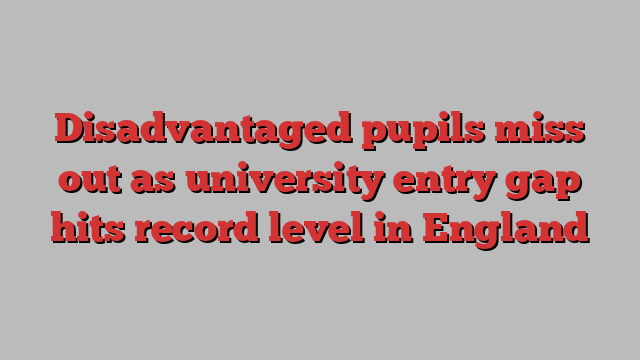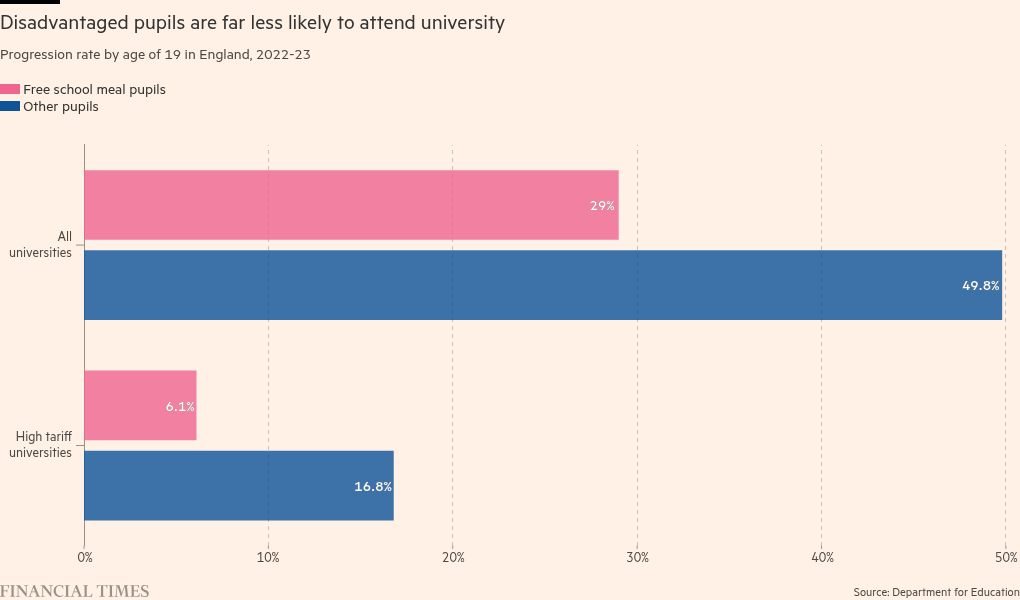
Unlock the Editor’s Digest for free
Roula Khalaf, Editor of the FT, selects her favourite stories in this weekly newsletter.
The gap between university entry rates for disadvantaged students and their peers in England has reached its highest level since records began in 2005.
Twenty-nine per cent of students who had received free school meals progressed to university by the age of 19, compared with 50 per cent of their peers, in the academic year 2022-23, according to government data.
The disparity in the progression rate climbed to 21 percentage points — up from the all-time low of 17 percentage points in the academic year ending in 2014, data released on Thursday showed. Free school meals are provided to children from families that receive certain welfare benefits.
The data reflects the disruption to learning caused by the Covid-19 pandemic compounded by rising living costs, which disproportionately affected outcomes for students from disadvantaged backgrounds, said analysts.
“There is a long tail of impact on those from disadvantaged backgrounds and so we could see the picture get worse as the attainment gap in schools has widened,” said Carl Cullinane, director of research and policy at social mobility charity the Sutton Trust.
“The pandemic and the cost of living crisis are going to cast a long shadow over the economy. Many people have said it is a ticking time bomb for social mobility,” he added.
The share of students on free school meals going on to university by age 19 fell for the first time on record in 2022-23. However, the progression gap has been widening for the past three years as entry rates for other students grew at a faster pace during the pandemic years.

Education secretary Bridget Phillipson said the data exposed “entrenched inequalities” that have been left to worsen for years.
“We all have a role to play in putting that right but when it comes to access to higher education for disadvantaged students, universities can and must do more,” she added.
Universities UK, which represents over 140 institutions, called on the government to increase the maintenance support package for students in the Budget on October 30, adding that more needed to be done to narrow the attainment gap in schools.
The gap in progression rates to the top-ranking universities reached a record 11 percentage points in 2022-23, despite a rise in the share of free school meals students who were awarded places.
More than 6 per cent of free school meals students went on to study at the high tariff universities by the age of 19. This was a record high but far lower than the rate for their peers, which reached almost 17 per cent.
Cullinane said that high tariff universities had boosted their intakes in recent years, but the bulk of the additional students were from more advantaged backgrounds.
“Universities have been focused on areas-based measures of disadvantage and tried to protect admissions from these groups because they did not have data on which students had access to free school meals,” he added.
The Russell Group, 24 research-intensive universities, said it was committed to increasing opportunities for disadvantaged students with “bold” access and participation strategies but acknowledged that challenges remained.
“A joined-up, cross-government approach, involving universities, schools, colleges and other partners, will be the most effective way to address the wider social, cultural and financial barriers.”